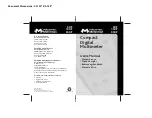
1MHz 100Hz
30MHz 1kHz
INPUT SENSOR
:
0.7V
。
Overload protection: 250V DC/AC peak value
2-9. hFE
Range Accuracy
Test
condition
hFE NPN or
PNP
0~1000
Current is 15uA, Vce is
approx. 4.5V
2.10 DIODE AND CONTINUITY TEST
Range Accuracy
Resolution
Diode forward volt
drop
Forward DCV is approx.
0.5mA, reversed voltage is
approx. 1.5V
If the resistance of the
two tested points is
less than (70±10)
Ω
,
buzzer sounds.
Open circuit voltage: 0.5V
Overload protection: 250V DC/AC peak value
WARNING: do not input any voltage at this range.
2.11 TEMP.
Range Accuracy
Resolution
-40
℃
-1000
℃
<
400 ±(0.8%+4)
℃
≥
400 ±(1.5%+15)
℃
1
℃
Thermocouple: K type
WARNING: do not input any
voltage at this range.
OPERATION
4-1. panel description
1. LCD displaying
2. Function keys:
2-1.RST key: when the meter
under sleep or lock states,
press this key, the meter will
be actived.
2-2.Hz/DUTY key:when measuring the AC voltage or AC current, it can switch
frequency/duty cycle/voltage(currect),when measuring the frequency, it can switch
frequency/duty cycle(1-99%).
2-3.REL key: press this key, clear the reading to Zero, enter relative value measuring.
2-4:HOLD key: press the key, the present measuring value is held on LCD and
display“HOLD”; press it again will exit the function and “HOLD” disappear.
2-5.Range key: select auto range or manual range.
2-6.DC/AC key,select DC/AC mode.
3.Knobe
:
change measuring function and range.
4.Temperature jack.
5.Voltage,Current,Resistance,Frequency,GND jack
6.Battery Case.
See the photo
4-2. DCV measurement
1 Insert the black lead to “COM” socket and the red one to “ V
Ω
Hz” socket;
2 Set the function switch to “V” range, press DC/AC key to select DC measuring
mode.
3.the default states is auto range, display”AUTO” symbol,press “range” key to select
manual range , you can choose 400mV
、
4V
、
40V
、
400V
、
1000V range.
4.connect the test leads to the test point ,voltage and polarity of the point which
connect with red test leads will be display on LCD.
NOTE:
1.
If “OL” displays, it means over-range, should set the range knob to a higher
range.
2.
The tested voltage can not be over 1000V DC; when changing function and
range, the leads must be away from the testing point.
3.
Be careful when measuring high voltage.
4-3. ACV measurement
1. Insert the black lead to “COM” socket and the red one to “ V
Ω
Hz” socket.
2. Set the function switch to “V” range, press DC/AC key to select AC measuring mode
3.the default states is auto range, display”AUTO” symbol,press “range” key to select
manual range , you can choose 400mV
、
4V
、
40V
、
400V
、
750V range.
4.connect the test leads to the test point ,voltage and polarity of the point which connect
with red test leads will be display on LCD.
NOTE:
1.
The 400mV range only has the manual range,if you need to use
400mV range,press “RANGE” key to select this range.
2.
If “OL” displays, it means over-range, should set the range knob to a
higher range.
3.
The tested voltage can not be over 750V AC; when changing function
and range, The leads must be away from the testing point.
4.
Be careful when measuring high voltage.
4-4. DCA measurement
1.
Insert the black lead to “COM” socket and the red one to “mA” or “20A”
socket.
2.
Set the function switch to “A” range, press DC/AC key to select DC
working mode,connect the test leads across to the circuit under tested,
the current value and polarity of the point which red lead connect will
display on LCD.
NOTE:
1.
If the measured current is unsure beforehand, should set the range
knob to a higher range, then, switch to a proper range according to
the displayed value.
2.
If “OL” displays, it means over-range, should set the range knob to a
higher range.
3.
When tested current
≥
10A under 20A range ,buzzer will be sound.
4.
Max. input current is 400mA or 20A
(
subject to where red lead
insert
),
excessive current will blow the fuse. Be careful when
measuring 20A due to un-fused. Continuously measuring large
current may heat the circuit, affect the accuracy, even damage the
meter.
4-5. ACA measurement
1.
Insert the black lead to “COM” socket and the red one to “mA” or “20A”
socket.
2.
Set the function switch to “A” range, press DC/AC key to select AC
working mode ,connect the test leads across to the circuit under tested,
the current value and polarity of the point which red lead connect will






















